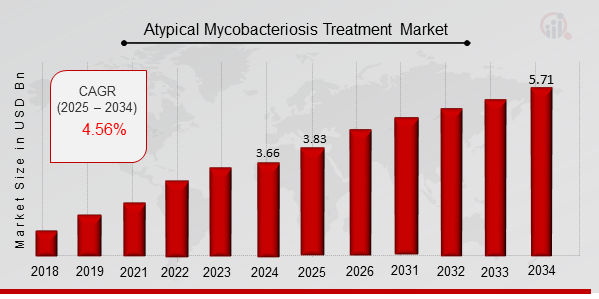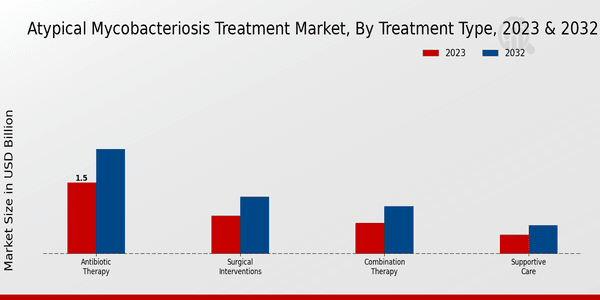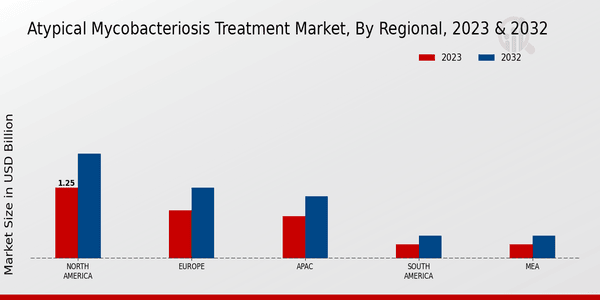Atypical Mycobacteriosis Treatment Market Overview:
As per MRFR analysis, the Atypical Mycobacteriosis Treatment Market Size was estimated at 3.66 (USD Billion) in 2024. The Atypical Mycobacteriosis Treatment Market Industry is expected to grow from 3.83 (USD Billion) in 2025 to 5.71 (USD Billion) till 2034, at a CAGR (growth rate) is expected to be around 4.56% during the forecast period (2025 - 2034).
Key Atypical Mycobacteriosis Treatment Market Trends Highlighted
The Atypical Mycobacteriosis Treatment Market, like any other industry market, has some key drivers which can be categorized as the market's dynamics. One of these drivers is the growing number of people contracting atypical mycobacterial disease which creates a demand for treatment. There’s definitely an acknowledgement amongst healthcare practitioners to use specific therapies which also propels growth in the market. Moreover, improved diagnostic techniques allow earlier and proper diagnostics of the infections and consequently better treatment. Furthermore, the development of atypical mycobacterial diseases’ understanding in the healthcare providers and the patients also causes this market’s growth.
This market has a lot of avenues that can be tapped towards growth. There is an increased amount of research and development processes that are undertaken to manufacture new therapeutic agents which offers opportunities for the pharmaceutical manufacturers. Also, the increasing weight of investment into biotechnological and personalized solutions promises a lot of room for creation of custom-made therapy provoked by concrete patient’s needs. In addition, innovative approaches in the market can enhance the overall mix due to joint ventures between academia and market players. There is also an immense potential in healthcare providers developing markets as these offer unexplored regions.
Recent trends indicate how technology could be incorporated into treatment processes with the inclusion of digital health solutions which would improve patient management and treatment adherence. The use of telemedicine is steadily increasing allowing patients to be able to receive their consultations and follow up without the need to travel. Also, there are talks of combining therapies to enhance their efficacy and overcome resistance. All these trends reflect the dynamics of the market and underline the necessity of responding to the evolving environment in healthcare with the aim of improving the outcome of patients with atypical mycobacterial infections.

Source: Primary Research, Secondary Research, MRFR Database and Analyst Review
Atypical Mycobacteriosis Treatment Market Drivers
Increasing Prevalence of Atypical Mycobacteriosis
The rise in the prevalence of atypical mycobacteriosis is a significant driver for the Atypical Mycobacteriosis Treatment Market industry. Atypical mycobacteriosis, caused by non-tuberculous mycobacteria (NTM), has increasingly been recognized as an important health concern, especially among immunocompromised individuals, the elderly, and those with underlying lung diseases. The growing awareness and diagnosis rates of this condition have led to a surge in demand for effective treatment options.
As healthcare providers become more knowledgeable about the disease, the development of guidelines for diagnosis and management has prompted patients to seek treatment for atypical mycobacterial infections. This increased patient awareness regarding symptoms and the need for effective management directly fuels market growth. Moreover, advancements in diagnostic technologies enable faster and more accurate identification of atypical mycobacterial infections, resulting in higher patient volumes requiring treatment.The Atypical Mycobacteriosis Treatment Market industry is therefore expected to expand as the number of diagnosed cases increases, driving the need for innovative therapies and treatment options.
Innovative Treatment Developments
One of the key drivers for the Atypical Mycobacteriosis Treatment Market industry is the continuous development of innovative treatment options. Pharmaceutical companies are increasingly focused on researching and developing new antibiotics and therapies that target atypical mycobacteriosis. This focus on innovation not only improves treatment outcomes but also addresses the growing issue of antibiotic resistance.
The introduction of more effective and specialized medications is anticipated to stimulate market growth, as healthcare providers seek the best possible treatments for their patients.Furthermore, the availability of combination therapy approaches that enhance efficacy and reduce treatment duration is likely to contribute positively to the market.
Supportive Government Policies and Funding
Supportive government policies and increased funding for research and treatment options represent another important driver for the Atypical Mycobacteriosis Treatment Market industry. Many governments worldwide are recognizing the need to support initiatives aimed at combating infectious diseases, including atypical mycobacteriosis.
This increased focus translates to more substantial investments in healthcare systems, research grants, and public health campaigns aimed at improving diagnostic capabilities and treatment access.Such initiatives not only facilitate better patient outcomes but also stimulate market growth by encouraging pharmaceutical companies to invest in the development of new therapies and enhancing the overall industry landscape.
Atypical Mycobacteriosis Treatment Market Segment Insights:
Atypical Mycobacteriosis Treatment Market Treatment Type Insights
The Atypical Mycobacteriosis Treatment Market has seen a steady evaluation in the Treatment Type segment, showcasing an evolving landscape characterized by distinct therapeutic approaches. In 2023, the market is valued at 3.35 USD Billion, with the Antibiotic Therapy segment commanding the largest share, valued at 1.5 USD Billion. This segment is significant due to its primary role in combating atypical mycobacterial infections, which are often resistant to standard treatments, making effective antibiotic regimens crucial in achieving patient recovery.
Following closely is the Surgical Interventions segment, with a valuation of 0.8 USD Billion in the same year, which is essential for cases where medical treatments do not yield satisfactory results or in instances involving severe infection complications. Combination Therapy, valued at 0.65 USD Billion in 2023, highlights its importance as a strategy that enhances treatment efficacy and minimizes resistance development, making it a valuable option in specific patient populations. Lastly, the Supportive Care segment, valued at 0.4 USD Billion, plays a crucial role in maintaining patient well-being and facilitating the healing process.
Collectively, these segments present a well-rounded approach to treating atypical mycobacterial infections, reflecting the market's acknowledgment of a multifaceted treatment strategy to address the complexity of these diseases. The projected growth towards 2032 indicates that the Antibiotic Therapy segment will continue to dominate, reaching an evaluation of 2.2 USD Billion, as antibiotic treatments remain the cornerstone of managing such infections. Surgical Interventions are expected to grow to 1.2 USD Billion, further underscoring their strategic role in advanced disease scenarios.
Combination Therapy, increasing to 1.0 USD Billion, illustrates its rising significance in enhancing treatment outcomes by integrating different therapeutic modalities. Meanwhile, Supportive Care's growth to 0.6 USD Billion emphasizes the increasing recognition of holistic treatment approaches that address the patient's overall health. This trajectory of growth is driven by various factors, including advancements in therapeutic research, increased prevalence of atypical mycobacterial infections, and a stronger focus on comprehensive patient care within the Atypical Mycobacteriosis Treatment Market industry.
Emphasizing these treatment types provides valuable insights into evolving strategies aimed at improving patient health outcomes, which will remain pivotal as the market progresses towards larger valuations and more refined treatment modalities. The interplay of these factors indicates a promising future, demonstrating potential opportunities for market participants to innovate and expand as the landscape matures.

Source: Primary Research, Secondary Research, MRFR Database and Analyst Review
Atypical Mycobacteriosis Treatment Market Pathogen Type Insights
The Atypical Mycobacteriosis Treatment Market, valued at 3.35 USD billion currently, is characterized by various pathogen types, with Mycobacterium Avium Complex, Mycobacterium Kansasii, Mycobacterium Abscessus, and Mycobacterium Chelonae serving as primary categories. Mycobacterium Avium Complex holds a considerable portion of the market due to its high prevalence in immunocompromised individuals and its association with chronic lung diseases. Meanwhile, Mycobacterium Kansasii, known for its significant role in pulmonary infections, serves as another critical focus within the market, driven by a rise in respiratory illnesses.
Mycobacterium Abscessus is gaining attention due to its resistance to standard treatments, creating a demand for innovative therapeutic solutions. Finally, Mycobacterium Chelonae, while less common, is increasingly recognized for its impact on post-surgical and skin conditions. The Atypical Mycobacteriosis Treatment Market data reveals that advancements in diagnostic technologies and rising awareness regarding atypical mycobacterial infections are major contributors to market growth. However, challenges such as treatment resistance and the need for tailored therapies persist, presenting both hurdles and opportunities within this evolving market landscape.
Atypical Mycobacteriosis Treatment Market Route of Administration Insights
In 2023, the Atypical Mycobacteriosis Treatment Market is projected to be valued at 3.35 USD Billion, reflecting growth within various segments, particularly the Route of Administration. This segment includes routes such as Oral, Intravenous, and Topical, which play significant roles in treatment, with Oral administration being a popular choice due to ease of use and patient compliance. The Intravenous route, while potentially less convenient, is often preferred in acute scenarios for its ability to deliver medications more directly and effectively, especially for patients who are severely affected.
Topical administration also holds substantial significance, particularly for localized treatment, enhancing effectiveness while minimizing systemic side effects. Overall, the Atypical Mycobacteriosis Treatment Market segmentation highlights a diverse landscape for treatment options, where each route addresses specific patient needs and conditions. This diversification contributes to the overall growth of the Atypical Mycobacteriosis Treatment Market revenue, bolstered by ongoing advancements in formulation technologies and increased awareness of atypical mycobacterial infections.Moreover, market trends suggest a rising focus on patient-centered approaches and personalized medicine, which further drives the evolution of administration routes in this industry.
Atypical Mycobacteriosis Treatment Market Patient Type Insights
The Atypical Mycobacteriosis Treatment Market revenue is driven significantly by the diverse needs of patients across different categories, particularly focusing on Patient Type. In 2023, the complete market was valued at approximately 3.35 billion USD, showcasing growth opportunities. Each patient type plays a unique role in the overall market dynamics, with Immunocompromised Patients accounting for a major share due to their heightened vulnerability to infections. Non-Immunocompromised Patients represent another critical segment, where treatment approaches differ and remain essential for effective management.
Additionally, Pediatric Patients bring significant attention, as their treatment often requires tailored approaches to minimize risks and adhere to safety protocols. The ongoing trends such as increasing healthcare accessibility, rising awareness about Atypical Mycobacteriosis, and evolving treatment guidelines are likely to shape market growth. However, challenges such as the need for specialized therapies and potential drug resistance present obstacles. Overall, understanding these distinctions among various patient types allows stakeholders to address specific needs and tailor their strategies, thereby enhancing the Atypical Mycobacteriosis Treatment Market statistics and fostering its expansion.
Atypical Mycobacteriosis Treatment Market Regional Insights
The Atypical Mycobacteriosis Treatment Market reflects a varied landscape across its regional segment, characterized by distinct market dynamics and valuations. In 2023, North America stands out with a significant valuation of 1.25 USD Billion, which is projected to grow to 1.85 USD Billion by 2032, thereby dominating the market due to its advanced healthcare infrastructure and rising prevalence of atypical mycobacterial infections. Europe follows with a valuation of 0.85 USD Billion in 2023, increasing to 1.25 USD Billion by 2032, driven by robust research initiatives and treatment advancements in the region.
The APAC region, valued at 0.75 USD Billion in 2023 and set to reach 1.1 USD Billion by 2032, is experiencing notable growth thanks to expanding healthcare access and increasing awareness of atypical mycobacteriosis. South America and MEA, each valued at 0.25 USD Billion in 2023, are forecasted to grow to 0.4 USD Billion by 2032, indicating a slower, yet consistent rise in addressing healthcare needs that could present future opportunities for market growth. The variations in market valuation and growth across these regions signify the diverse challenges and drivers impacting the Atypical Mycobacteriosis Treatment Market, with North America holding the majority market share.

Source: Primary Research, Secondary Research, MRFR Database and Analyst Review
Atypical Mycobacteriosis Treatment Market Key Players and Competitive Insights:
The Atypical Mycobacteriosis Treatment Market is characterized by advancements in medical research and the development of novel therapeutic agents targeting atypical mycobacterial infections. As healthcare providers increasingly recognize the clinical significance of atypical mycobacterial infections, the market is experiencing a shift toward more effective treatment options. The competitive landscape is shaped by various pharmaceutical companies focusing on innovation, strategic partnerships, and regulatory approvals to meet the growing demand for therapies. The market dynamics are influenced by factors such as rising prevalence rates, increasing awareness of atypical mycobacterial diseases, and a strong emphasis on improving treatment outcomes. Such factors drive companies to enhance their product portfolios and leverage cutting-edge technologies, establishing a competitive advantage.
Sanofi has established a strong presence in the Atypical Mycobacteriosis Treatment Market by leveraging its research capabilities and extensive portfolio of pharmaceutical products. The company's commitment to innovation and patient-centered solutions positions it favorably among competitors. Sanofi's strength lies in its ability to integrate advanced research practices with patient needs, ensuring that therapies developed are not only effective but also accessible to those affected by atypical mycobacterial infections. The company's robust pipeline includes various candidates specifically targeting atypical mycobacteriosis, highlighting its dedication to addressing this significant area of public health concern. Furthermore, Sanofi's extensive global distribution network enables it to reach a wide audience, enhancing its market presence and reinforcing its competitive position.
Merck and Co have made significant contributions to the Atypical Mycobacteriosis Treatment Market through its focused research efforts and commitment to developing effective treatment options. The company’s expertise in infectious diseases allows it to understand the complexities of atypical mycobacterial infections, ultimately contributing to more targeted therapies. Merck and Co's strengths include its extensive experience in drug development, strong regulatory relationships, and an established reputation in the pharmaceutical industry. This positions the company well to respond to the demands of the atypical mycobacteriosis market, facilitating the rapid advancement of its products through research and clinical phases. Additionally, the company's dedication to collaboration with healthcare professionals and institutions underscores its strategic approach to filling existing gaps in treatment availability and efficacy within the market.
Key Companies in the Atypical Mycobacteriosis Treatment Market Include:
- Sanofi
- Merckand Co
- GSK
- AbbVie
- AstraZeneca
- Astellas Pharma
- BristolMyers Squibb
- Teva Pharmaceutical
- Mylan
- Pfizer
- Eli Lilly
- Johnsonand Johnson
- Roche
- Novartis
- HoffmannLa Roche
Atypical Mycobacteriosis Treatment Market Industry Developments
Recent developments in the Atypical Mycobacteriosis Treatment Market are showcasing significant advancements and growing interest from major pharmaceutical companies. Companies such as Sanofi, Merck & Co, and GSK are focusing on research and development to enhance treatment options, improving patient outcomes in managing atypical mycobacterial infections. Additionally, funds and investments from AbbVie, AstraZeneca, and Roche are helping to stimulate innovation in this sector. The market is also witnessing increased collaboration between these companies, which is driving competitive strategies for growth.
Recent mergers and acquisitions have been noted, with AstraZeneca announcing a strategic acquisition aimed at expanding its portfolio in infectious disease treatment, while Pfizer is reportedly seeking partnerships to enhance its pipeline for atypical mycobacterial therapies. The financial momentum is reflected in the growing valuation of companies including Bristol-Myers Squibb and Johnson & Johnson, indicating a robust market outlook. The combined efforts and robust pipeline initiatives of Teva Pharmaceutical, Mylan, and Novartis contribute to a dynamic atmosphere in the market, with increased focus on innovative solutions for atypical mycobacterial treatments poised to shape the future landscape of this industry.
Atypical Mycobacteriosis Treatment Market Segmentation Insights
- Atypical Mycobacteriosis Treatment Market Treatment Type Outlook
- Antibiotic Therapy
- Surgical Interventions
- Combination Therapy
- Supportive Care
- Atypical Mycobacteriosis Treatment Market Pathogen Type Outlook
- Mycobacterium Avium Complex
- Mycobacterium Kansasii
- Mycobacterium Abscessus
- Mycobacterium Chelonae
- Atypical Mycobacteriosis Treatment Market Route of Administration Outlook
- Atypical Mycobacteriosis Treatment Market Patient Type Outlook
- Immunocompromised Patients
- Non-Immunocompromised Patients
- Pediatric Patients
- Atypical Mycobacteriosis Treatment Market Regional Outlook
- North America
- Europe
- South America
- Asia Pacific
- Middle East and Africa
| Report Attribute/Metric |
Details |
|
Market Size 2024
|
3.66 (USD Billion)
|
|
Market Size 2025
|
3.83 (USD Billion)
|
|
Market Size 2034
|
5.71 (USD Billion)
|
|
Compound Annual Growth Rate (CAGR)
|
4.56 % (2025 - 2034)
|
|
Report Coverage
|
Revenue Forecast, Competitive Landscape, Growth Factors, and Trends
|
|
Base Year
|
2024
|
|
Market Forecast Period
|
2025 - 2034
|
|
Historical Data
|
2020 - 2024
|
| Market Forecast Units |
USD Billion |
| Key Companies Profiled |
Sanofi, Merck and Co, GSK, AbbVie, AstraZeneca, Astellas Pharma, BristolMyers Squibb, Teva Pharmaceutical, Mylan, Pfizer, Eli Lilly, Johnson and Johnson, Roche, Novartis, HoffmannLa Roche |
| Segments Covered |
Treatment Type, Pathogen Type, Route of Administration, Patient Type, Regional |
| Key Market Opportunities |
Increased prevalence of infections, Growing demand for personalized therapies, Advances in diagnostic technologies, Expansion of telemedicine services, Rising investment in R initiatives |
| Key Market Dynamics |
Increasing prevalence of infections, Growing awareness and diagnosis, Advances in drug development, Rising healthcare expenditures, Emerging markets growth potential |
| Countries Covered |
North America, Europe, APAC, South America, MEA |
Frequently Asked Questions (FAQ) :
The market is expected to be valued at 5.71 USD Billion by 2034.
The projected CAGR for the market is 4.56% from 2025 to 2034.
North America is expected to hold the largest share, valued at 1.85 USD Billion in 2032.
Major players in the market include Sanofi, Merck and Co, GSK, and Abbott.
The market value for Antibiotic Therapy is expected to reach 2.2 USD Billion by 2032.
The market for Surgical Interventions is projected to grow to 1.2 USD Billion by 2032.
The market for Combination Therapy is anticipated to be valued at 1.0 USD Billion in 2032.
The market value for Supportive Care is predicted to reach 0.6 USD Billion by 2032.
Europe's market size is expected to reach 1.25 USD Billion by 2032.
The market value for South America is estimated to grow to 0.4 USD Billion by 2032.


















